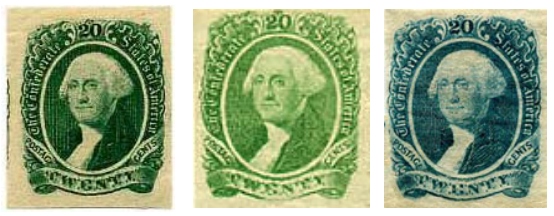Catalog Numbers are from the Confederate States of America Catalog and Handbook of Stamps and Postal History

Left: Green -- Middle: Yellow Green - Right: Bluish Green
The central motif, a portrait of George Washington, was designed and line engraved on steel by John Halpin. It was then transferred to a steel printing plate of 200 subjects consisting of two panes of 100 separated by a single vertical gutter. Based on incomplete records, it is estimated that there were approximately 2,350,000 stamp. Full panes of one hundred are known. The earliest recorded date of use is June 1, 1863. Colors vary from green to deep green, milky green, bluish green, and yellow green. Plating is incomplete. It was printed on white wove paper of varied thickness with colorless gum and issued imperforate.
The inscription "Archer & Daly, Richmond, Va" is found only on the sheets of the first printing; the second printing sheets have no inscription. Double transfers are known, as well as the "20 on the forehead" variety. The most typical use was to pay the 20-cent overweight double letter rate, with pairs known paying the 40-cent Trans-Mississippi rate and bisects paying the 10-cent letter rate. The 20-cent stamp was printed primarily to be used as small change, the lowest denomination of CSA currency being a 50-cent fractional note. The Confederacy had no coins. Used copies are scarcer than unused.
For many years, it was believed that John's Halpin's brother Frederick had engraved these stamps but, in 2015, Halpin descendant Jeffrey Hawkins proved that it was Frederick's brother John (both were engravers) who engraved the stamps. The story of these two brothers was published in The Confederate Philatelist, the journal of the Confederate Stamp Alliance. The publications of August Dietz from 1929 through 1986 had the incorrect information, as does the 2012 CSA Catalog, as the new information had not yet come to light at the time it was published.